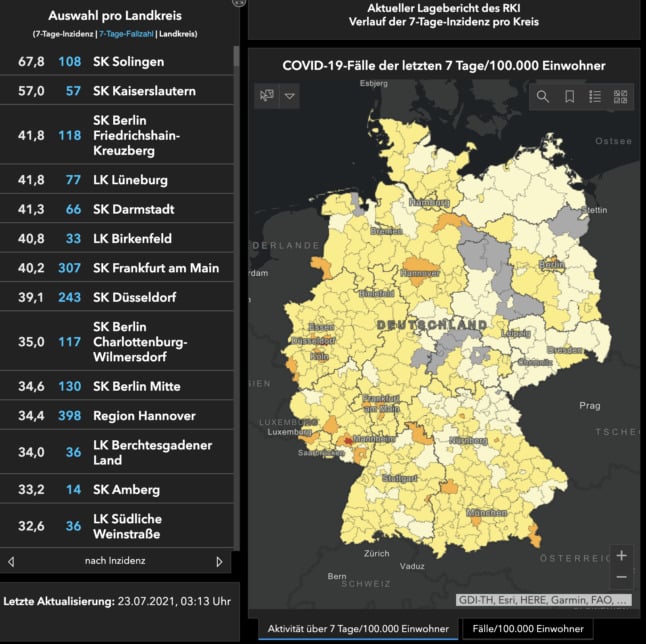Which age group is seeing the highest number of Covid cases?
Not surprisingly, young people are seeing the most amount of Covid cases in Germany right now, as most of public life has opened up across the country.
The highest incidence in age groups – 32 cases per 100,000 residents in seven days (7-day incidence) – is among young people aged between 15 and 24, the Robert Koch Institute (RKI) said in its latest report.
People in these age groups tend to rarely see severe effects from Covid-19. Vaccination rates in people younger than 60 are also much lower than among those older than 60.
In the older age groups, fewer than five cases per 100,000 population have been recorded within seven days.
READ ALSO: Prepare for autumn and winter: RKI warns of Covid spike
What’s the overall picture?
The 7-day incidence has been rising for more than two weeks. On Friday, the RKI reported 13.2 infections per 100,000 people within a seven-day period nationwide. On the previous day, the incidence was 12.2 cases per 100,000 – and the most recent low on July 6th was 4.9.
On Friday, 2,089 Covid cases were reported within 24 hours. A week ago there were 1,456 infections within this time period. A total of 34 Covid deaths were recorded in the last 24 hours.
“Due to the still low overall incidence, the health authorities are able to trace many infection chains,” said the RKI.
The highest incidences among the 16 federal states are Berlin (with 21.8 cases per 100,000 residents), Hamburg (18.5 cases per 100,000) and Saarland (19.3 cases), as the tweet below by German data journalist Olaf Gersemann points out.
The lowest 7-day incidences per 100,000 people are in Mecklenburg-Western Pomerania (3 cases), Saxony (5.3 cases) and Thuringia (4.8 cases).
Die 7-Tage-#Corona-Inzidenz in 🇩🇪 steigt weiter, von 12,2 auf 13,2.
➡️ 17. Anstieg in Folge
➡️ höchste Inzidenzen in #Berlin (21,8), #Hamburg (18,5) und dem #Saarland (19,3)@welt pic.twitter.com/a0j3Sc4ogh
— Olaf Gersemann (@OlafGersemann) July 23, 2021
For districts, Solingen in North Rhine-Westphalia, Kaiserslautern in Rhineland-Palatinate, and Berlin’s Friedrichshain have the highest 7-day incidences, as the below map and ranking by the RKI shows.

Is travel having an impact?
Yes, it’s becoming more of a contributing factor to the spread, according to experts.
The RKI said more cases are being reported by those exposed to the virus abroad. The most common country at present where people are getting Covid is Spain. The popular vacation destination has a significantly higher number of Covid infections than Germany.
TRAVEL: Germany poised to put Spain and the Netherlands on ‘high incidence’ list

What’s happening in hospitals?
So far in the pandemic, the 7-day incidence has been the most important factor when deciding Covid restrictions, whether it’s stricter contact rules or closures.
But now due to risk groups being having more protection because of vaccinations, Germany is looking at other factors such as hospital data in more detail. Since mid-June, hospitals have been asked to report more data so the overall situation can be evaluated better.
The RKI said that the trend in the decline in the number of patients in hospitals and intensive care units is not continuing – and hospitalisations are going up. However, the numbers are still at a low level.
According to the latest report, by Germany’s intensive care register (DIVI), there are around 357 Covid-19 patients in hospitals across Germany, with 207 (58 percent) receiving ventilation treatment.
During peaks of the pandemic – such as October last year and January this year – more than 5,000 Covid patients were hospitalised in Germany.
What about variants?
The Delta variant, first discovered in India has been dominant in Germany for a few weeks now. In a randomly selected sample for analyses, its share in new Covid cases in Germany was 84 percent, said the RKI. This is a further increase compared to the previous week, when the proportion had been around two-thirds.
Germany has been watching countries, such as the UK closely. It has seen massive spikes in Covid cases fuelled by the more transmissible Delta variant.
Other European countries are seeing a similar trend, as shown in the chart below by Our World in Data.
What do we know about vaccine effectiveness?
The “vast majority” of Covid-19 cases recorded since February 1st have been among people who are not vaccinated against the virus, the report said.
According to the RKI’s estimates, vaccine effectiveness for the period from early February to July 11th is about 89 percent for people aged 18 to 59, and about 87 percent for people aged 60 and older.
However, since the beginning of February a total of 6,125 so-called “vaccination breakthroughs” (Impfdurchbrüche) – infections in people who are already vaccinated – have been recorded, the RKI says.
These cases are mostly mild infections. And the RKI says they are rare compared to the number of fully vaccinated people, of which there are currently about 40 million people in Germany.
Of those affected over the age of 60, about a quarter of people had to go to hospital, according to the RKI.
What should people in Germany do?
Get vaccinated as soon as possible, say the experts.
The RKI said the health risk to unvaccinated people or those who’ve had just one jab “remains high”.
“For those who have been fully vaccinated the risk to health is moderate.” they said.
The RKI urged people to continue following mask and distance rules and to “avoid situations in which so-called super-spreading events can occur as far as possible”.
“It is also strongly recommended to take advantage now of offers for vaccination against Covid-19,” advised the RKI.
READ ALSO:
- Merkel urges Germans to get vaccinated amid warnings of ‘exponential growth’
- ‘Prepare for autumn and winter’: Germany’s RKI warns of Covid spike
Just over 60 percent of the German population has at least one jab, and 48.5 percent is fully vaccinated.
As the number of vaccinations being administered in Germany has slowed down in recent weeks, experts are urging authorities to get vaccines out to people.
High profile virologist Christian Drosten said he is “increasingly concerned about the progress of vaccination”.
“Here, we are not progressing fast enough, even though there is enough vaccine available,” said the virologist.
Drosten said many people have a false sense of security in light of the low incidence rates in Germany.
“It is important to work to educate (people) now – also in our private lives – so that the vaccination rate increases more quickly,” he said.




 Please whitelist us to continue reading.
Please whitelist us to continue reading.
Member comments